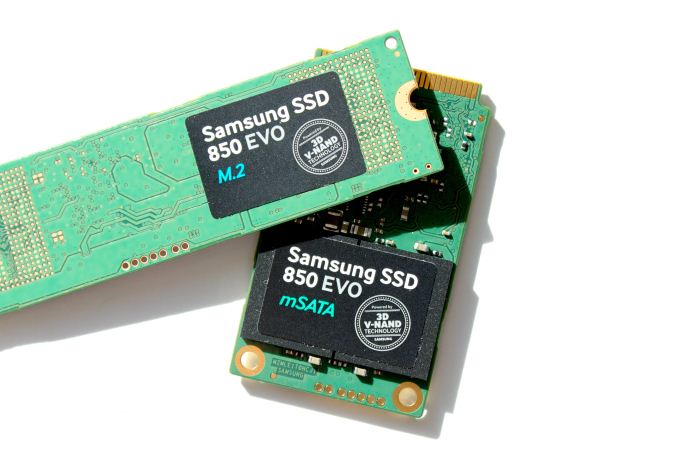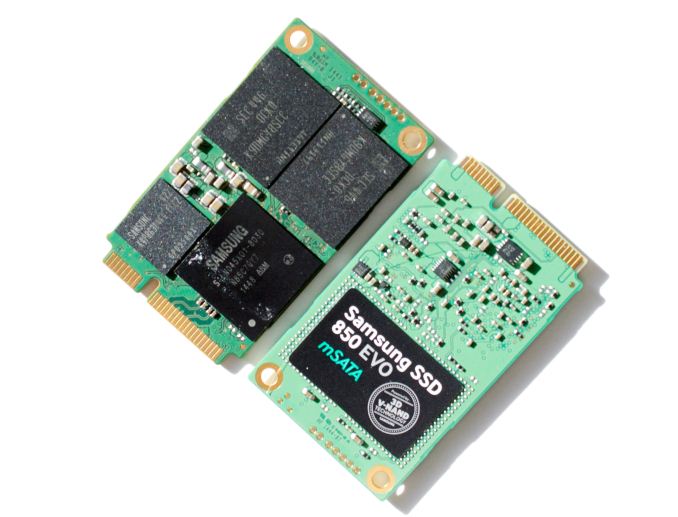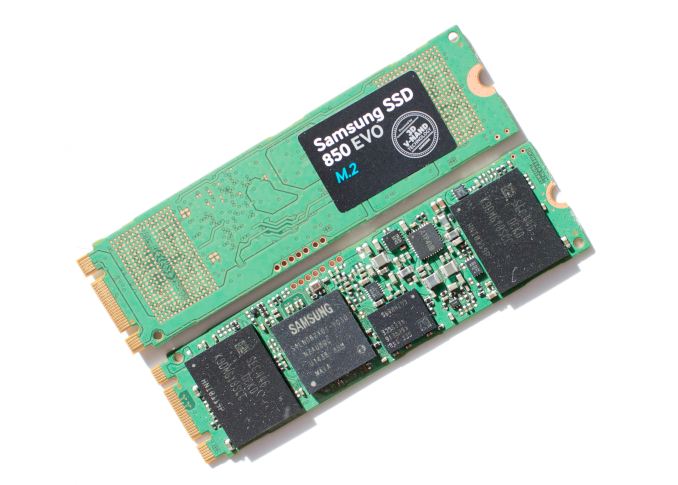The Samsung SSD 850 EVO mSATA/M.2 Review
by Kristian Vättö on March 31, 2015 10:00 AM EST
Four months ago Samsung introduced the world to TLC V-NAND in the form of SSD 850 EVO. It did well in our tests and showed that 3D NAND technology essentially brings TLC NAND to the level where planar MLC NAND stands today. The initial launch only included the most popular form factor in 2.5", but did not address the upgrade market where mSATA and M.2 are constantly growing in popularity. With today's release, Samsung is expanding the 850 EVO lineup with M.2 and mSATA models.
The move isn't really surprising because Samsung released an mSATA version of the SSD 840 EVO a bit over a year ago and when the 850 EVO was originally launched we were told that mSATA and M.2 models would follow later. The addition of M.2 is new to Samsung's retail lineup, but it makes a lot of sense given that many PC OEMs have switched from mSATA to M.2, and ultimately M.2 will be replacing mSATA in full.
Architecturally the mSATA and M.2 models are not any different from their 2.5" sibling. The heart of the drives is still Samsung's own MGX controller (excluding the 1TB model, which is powered by the older MEX controller) and the NAND is 32-layer 128Gbit TLC (3-bit per cell) V-NAND that is manufactured using 40nm lithography. TurboWrite (Samsung's pseudo-SLC caching) is also included and the cache sizes have remained unchanged from the 2.5" model. DevSleep and TCG Opal 2.0 (eDrive) are both supported too and endurance comes in at a respectable 75TB for 120GB/250GB and 150TB for 500GB/1TB models.
Given the similarity with the 2.5" model, I strongly suggest that you read our 850 EVO review for a full scope of TurboWrite, TLC V-NAND and other tidbits as I won't be covering those in detail in this review.
| Samsung SSD 850 EVO mSATA Specifications | |||||
| Capacity | 120GB | 250GB | 500GB | 1TB | |
| Form Factor | mSATA | ||||
| Controller | Samsung MGX | Samsung MEX | |||
| NAND | Samsung 40nm 128Gbit TLC V-NAND | ||||
| DRAM (LPDDR2) | 512MB | 1GB | |||
| Sequential Read | 540MB/s | 540MB/s | 540MB/s | 540MB/s | |
| Sequential Write | 520MB/s | 520MB/s | 520MB/s | 520MB/s | |
| 4KB Random Read (QD1) | 10K IOPS | 10K IOPS | 10K IOPS | 10K IOPS | |
| 4KB Random Read (QD32) | 95K IOPS | 97K IOPS | 97K IOPS | 97K IOPS | |
| 4KB Random Read (QD1) | 40K IOPS | 40K IOPS | 40K IOPS | 40K IOPS | |
| 4KB Random Write (QD32) | 88K IOPS | 88K IOPS | 88K IOPS | 88K IOPS | |
| Steady-State 4KB Random Write Performance | 3.1K IOPS | 4.9K IOPS | 6.8K IOPS | 9.7K IOPS | |
| DevSleep Power Consumption | 2mW | 2mW | 2mW | 4mW | |
| Slumber Power Consumption | 50mW | ||||
| Active Power Consumption (Read/Write) | Max 3.5W / 4.3W | ||||
| Encryption | AES-256, TCG Opal 2.0, IEEE-1667 (eDrive) | ||||
| Endurance | 75TB (41GB/day) | 150TB (82GB/day) | |||
| Warranty | Five years | ||||
Like its predecessor, the 850 EVO mSATA offers capacity of up to 1TB, which still remains the highest capacity mSATA drive in the industry. Samsung has a substantial lead in its NAND packaging technology because currently no-one else is shipping 16-die packages in high volume and by comparison Samsung has been doing this for quite some time now. I've heard Toshiba has some 16-die packages available, but the yields are very low and pricing comes in at about a dollar per gigabyte, whereas other packages are priced at ~30 cents per gigabyte. Micron also has 16-die packages on paper, but I've yet to see them used in any actual products.
| Samsung SSD 850 EVO M.2 Specifications | ||||
| Capacity | 120GB | 250GB | 500GB | |
| Form Factor | M.2 2280 (single-sided; SATA 6Gbps) | |||
| Controller | Samsung MGX | |||
| NAND | Samsung 40nm 128Gbit TLC V-NAND | |||
| DRAM (LPDDR2) | 512MB | |||
| Sequential Read | 540MB/s | 540MB/s | 540MB/s | |
| Sequential Write | 500MB/s | 500MB/s | 500MB/s | |
| 4KB Random Read (QD1) | 10K IOPS | 10K IOPS | 10K IOPS | |
| 4KB Random Read (QD32) | 97K IOPS | 97K IOPS | 97K IOPS | |
| 4KB Random Write (QD1) | 40K IOPS | 40K IOPS | 40K IOPS | |
| 4KB Random Write (QD32) | 89K IOPS | 89K IOPS | 89K IOPS | |
| Steady-State 4KB Random Write Performance | 2.8K IOPS | 4.1K IOPS | 5.8K IOPS | |
| DevSleep Power Consumption | 2mW | 2mW | 2mW | |
| Slumber Power Consumption | 50mW | |||
| Active Power Consumption (Read/Write) | Max 2.4W / 3.5W | |||
| Encryption | AES-256, TCG Opal 2.0, IEEE-1667 (eDrive) | |||
| Endurance | 75TB (41GB/day) | 150TB (82GB/day) | ||
| Warranty | Five years | |||
Unfortunately the M.2 version tops out at 500GB. The reason lies in the fact that the M.2 is a single-sided design, which only has room for two NAND packages. There are quite a few laptops that use the single-sided M.2 2280 form factor as it allows for thinner designs, but I still would have liked to see a 1TB double-sided version. It is worth noting that while both PCIe and SATA based devices can have M.2 form factors, Samsung is only releasing the 850 EVO M.2 in the SATA format at this time.
With a 128Gbit die and sixteen die per package, the maximum capacity for each package comes in at 256GiB, yielding a raw NAND capacity of 512GiB, of which 500GB is usable in the 850 EVO.
| AnandTech 2015 SSD Test System | |
| CPU | Intel Core i7-4770K running at 3.5GHz (Turbo & EIST enabled, C-states disabled) |
| Motherboard | ASUS Z97 Deluxe (BIOS 2205) |
| Chipset | Intel Z97 |
| Chipset Drivers | Intel 10.0.24+ Intel RST 13.2.4.1000 |
| Memory | Corsair Vengeance DDR3-1866 2x8GB (9-10-9-27 2T) |
| Graphics | Intel HD Graphics 4600 |
| Graphics Drivers | 15.33.8.64.3345 |
| Desktop Resolution | 1920 x 1080 |
| OS | Windows 8.1 x64 |
- Thanks to Intel for the Core i7-4770K CPU
- Thanks to ASUS for the Z97 Deluxe motherboard
- Thanks to Corsair for the Vengeance 16GB DDR3-1866 DRAM kit, RM750 power supply, Hydro H60 CPU cooler and Carbide 330R case












58 Comments
View All Comments
cleverdude - Saturday, April 18, 2015 - link
Bench results have not been updated.http://www.anandtech.com/bench/SSD/65
szhosain - Monday, May 4, 2015 - link
On my Lenovo W530 laptop (about 3 years old now), I just installed a Samsung 850 EVO MSATA 1TB card, and ATTO shows me poorer numbers than seen here. About 267 MB/sec for write and 280 MB/sec for read when it peaks. My 2.5" SSD drives (from OCZ) in the same system are well over 500 MB /sec.Does this perhaps mean that the MSATA interface on this laptop is limited to 3 GB/sec rather than the 6 GB /sec on the standard SATA interfaces?
That would be quite irritating!
Ethos Evoss - Sunday, June 21, 2015 - link
When it comes to mSATA or M.2 connected to SATA III there is no point purchase stupid expensive SSDs as they will perform same as cheapest ones ..So best mSATA/m.2 SSD for SATA III use is the plextor or mushkin (i preffer plextor) which cost less and has great performance
Andrew Field - Wednesday, August 5, 2015 - link
This Samsung SSD 850 EVO mSATA constantly overheats. This is especially the case when copying large files. It rises about 10C every 30-60 seconds, and does not stop until its own overheating protection kicks in. This occurs when it is in a laptop or in an external enclosure (even when open and exposed to the air).Initially I thought I had a bad piece of hardware, but I tested 5 separate units with consistent results.
If anyone decides to test this out, I did the following:
- Step 1: Select a folder with at least 100GB of data
- Step 2: Copy said folder to a new folder (on the same Samsung SSD 850 EVO mSATA)
- Step 3: Monitored the temperature
Result: The temperature begins rising sharply in a few seconds, and does not stop rising until the SSD engages its overheating protection.
greywarden - Thursday, September 17, 2015 - link
I was about to purchase (4) 250GB 850 EVO mSATA drives to put in an Addonics quad mSATA PCIe card, but seeing the latency numbers on the drive has me concerned. Should I look into purchasing a pair of the 500GB models instead? Have the pausing and crashing problems been solved with the 1TB model yet?payamfi - Tuesday, January 19, 2016 - link
Hi guys i wanna buy a memmory for my n551jx i can not decide what to buy msata evo mini or ssd evo pro can anyone help me out?fabbrimichele75 - Friday, March 25, 2016 - link
Would it be possible to know the temperature when the disk is in idle and full load?I'm mainly interested in the M.2 version.
I'm asking because I wanted to mount it on an NUC 6i5 that seems to be sensitive to high temperature.
yolomolo - Tuesday, April 19, 2016 - link
Can i get some advice from you PRO, should i better go get mSata : Samsung EVO 850 or CRUCIAL MX200 ?